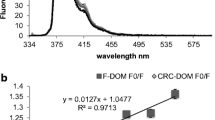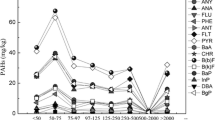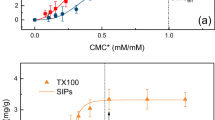Abstract
Cocamidopropyl hydroxysultaine (CAS) has been used in a pilot plant study as a biodegradable surfactant for the extraction of polycyclic aromatic hydrocarbons (PAHs) and lead (Pb) from contaminated soils. The soil treatment has been done in flotation cells with a concentration of 0.20 g CAS L−1 in saline conditions (3 M NaCl) and using a pulp density of 20% (w/w). The process integrates the recirculation of the liquid phases separated from the soil by centrifugation or filtration. Thus, it was necessary to understand CAS-PAHs micellar behavior and to follow the behavior and the fate of the surfactant in the process. 1-8-anilino-naphthalene sulfonate (ANS) is used as a fluorophor compound in the ANS enhanced fluorescence technique. A three-dimensional model detailing the change in the micellar behavior at high NaCl concentration and at different pH has been established. Fluorescence results of centrifuged soil matrix containing CAS have been compared to the results from synthetic solutions assays. A method allowing an accurate titration of the CAS has been developed by using the exact same matrix of the soil as the tested samples for the preparation of the calibration curves. The study of the surfactant concentration in the process has been performed and allows the adjustment of the CAS concentration in the recirculated water.






Similar content being viewed by others
References
APHA. (1999). Standards methods for examination of water and wastewaters. American Public Health Association (APHA), American Water Works Association (AWWA) and Water Pollution Control Federation (WPCF), Washington, DC.
Auriol, M., Filali-Meknassi, Y., Tyagi, R. D., Adams, C. D., & Surampalli, R. Y. (2006). Endocrine disrupting compounds removal from wastewater, a new challenge. Process Biochemistry, 41, 525–539.
Bakas, L. S., & Disalvo, E. A. (1991). Effect of encapsulated calcium on the surface properties of curved phosphatidylcholine bilayers. Biochimica Biophysica Acta Biomembranes, 1065(2), 114–120.
Birdi, K. S., Krag, T., & Klausen, J. (1977). Determination of critical micelle concentration of anionic micellar systems by anilinonaphthalenesulfonate (ANS) in aqueous solutions. Journal of Colloid and Interface Science, 62, 562–563.
Birdi, K. S., Singh, H. N., & Dalsager, S. U. (1979). Interaction of ionic micelles with the hydrophobic fluorescent probe 1-anilino-8-naphthalenesulfonate. Journal of Physical Chemistry, 83(21), 2733–2737.
Djedidi, Z., Drogui, P., Ben Cheikh, R., Mercier, G., & Blais, J. F. (2005). Laboratory study of successive soil saline leaching and electrochemical lead recovery. Journal of Environmental Engineering (ASCE), 131, 305–314.
Eriksson, J. C., Ljunggren, S. (1990). Model Calculations on the Transitions between Surfactant Aggregates of Different Shapes. American Chemical Society .Vol. 6, No. 5.
Gasymov, O. K., Abduragimov, A. R., & Glasgow, B. J. (2007). Characterization of fluorescence of ANS-tear lipocalin complex: evidence for multiple-binding modes. Photochemistry and Photobiology, 83(6), 1405–1414.
Gibbons, D. L., & Horowitz, P. M. (1995). Exposure of hydrophobic surfaces on the chaperonin GroEL oligomer by protonation or modification of His-401. Journal of Biological Chemistry, 270(13), 7335–7340.
Hines, J. D., Garrett, P. R., & Rennie, G. K. (1997). Structure of an adsorbed layer of n-Dodecyl-N,N-dimethylamino acetate at the air/solution interface as determined by neutron reflection. Journal of Physical Chemistry, 101(36), 7121–7126.
Huang, H. L., & Lee, W. M. G. (2001). Simultaneous absorption of vapor phase polycyclic aromatic hydrocarbon and carbon dioxide in anionic surfactant solutions. Journal of Environmental Science and Health. Part A, Toxic/Hazardous Substances & Environmental Engineering, 36(7), 1187–1204.
Kudaibergenov, S. K. (2002). Polyampholites: Synthesis, characterization and applications (p. 220). New York: Kluwer.
Lackowicz, J. R. (1983). Principles of fluorescence spectroscopy (p. 516). New York: Plenum.
Li, J. L., & Chen, B. H. (2002). Cloud-point extraction of phenanthrene by nonionic surfactants. Journal of the Chinese Institute of Chemical Engineers, 33(6), 581–589.
Lopez, J., Iturbe, R., & Torres, L. G. (2005). Washing of soil contaminated with PAHs and heavy petroleum fractions using two anionic and one ionic surfactant: Effect salt addition. Journal of Environmental Science and Health Part A, 39, 2293–2004.
Lucy, C. A., & Tsang, J. S. W. (2000). Determination of surfactant concentration using micellar enhanced fluorescence and flow injection titration. Talanta, 50, 1283–1289.
Mast, R. C., & Haynes, L. V. (1975). The use of the fluorescent probes perylene and magnesium-8-anilinonaphthalene-1-sulfonate to determine the critical micelle concentration of surfactants in aqueous solution. Journal of Colloid and Interface Science, 53, 35–41.
MDDEP. (2001). Méthode d’analyse : Détermination des HAPs-dosage par chomatographie en phase gazeuse couplée à un spectromètre de masse. MA. 400-HAP 1.1, Centre d’expertise en analyze environnementale, Québec, Canada, 44 p.
MDDEP. (2006). Méthode d’analyse : Détermination des biphényles polychlorés, des chlorobenzènes et des hydrocarbures aromatiques polycycliques : extraction et purification sur phase solide (SPE) et dosage par chromatographie en phase gazeuse couplée à un spectromètre de masse. MA. 400-SPE-BPC/Clbz/HAP 1.0, Centre d’expertise en analyze environnementale, Québec, Canada, 51 p.
MDDEPQ. (1999). Politique de protection des sols et de réhabilitation des terrains contaminés. Ministère du développement durable de l’environnement et des parcs du Québec, Gouvernement du Québec, Québec, Canada, 132 p.
Mercier, G., Duchesne, J., & Blackburn, D. (2001). Removal of metals from contaminated soils by mineral processing techniques followed by chemical leaching. Water, Air, and Soil Pollution, 135, 105–130.
Mercier, G., Mouton, J., Blais, J. F., Drogui, P., Chartier, M. (2007). Traitement simultané et dans un même réacteur de sols contaminés par des molécules organiques hydrophobes et des métaux. Canada Patent Pending, No. CA 2,605,053.
Moore, S. A., & Palepu, R. M. (2006). Spectroscopic investigations on the interaction of an anionic probe with nonionic micelles of Igepal surfactants in aqueous media. Molecular Physics, 104(20–21), 3155–3159.
Mouton, J. (2008). Procédé simultané de traitement de sols contaminés par des HAP et du plomb. Ph.D. thesis, INRS-ETE, Université du Québec, Québec, QC, Canada, 208 p.
Mouton, J., Mercier, G., & Blais, J. F. (2009). Amphoteric surfactants for PAH and lead polluted-soil treatment using flotation. Water, Air, and Soil Pollution, 197, 381–393.
Norton, D., Zheng, J., Danielson, N. D., & Shamsi, S. A. (2005). Capillary electrochromatography–mass spectrometry of zwitterionic surfactants. Analytical Chemistry, 77, 6874–6886.
Nsimba, Z. F., Paquot, M., Mvumbi, L. G., & Deleu, M. (2010). Glycine betaine surfactant derivatives: Synthesis methods and potentialities of use | [Les dérivés tensioactifs de la glycine bétaïne: Méthodes de synthèse et potentialités d’utilisation]. Biotechnology, Agronomy, Society and Environment, 14(4), 737–748.
Rosen, M. J., Zhao, F., & Murphy, D. S. (1987). Two-phase mixed indicator method for the determination of zwitterionic surfactants. Journal of American Oil Chemistry Society, 64(3), 439–441.
Schmitt, T. M. (1992). Analysis of surfactants. Chapter 11. New York: Marcel Dekker.
Schonbrunn, D., Eschenburg, S., Luger, K., Kabsch, W., & Amrhein, N. (2000). Structural basis for the interaction of the fluorescence probe 8-anilino-1-naphthalene sulfonate (ANS) with the antibiotic target MurA. Proceedings of the National Academy of Sciences, 97, 6345–6349.
Swisher, R. D. (1987). Surfactant biodegradation, surfactant science series (2nd ed., p. 965). New York: Dekker.
Vaillier, J., & Vaillier, D. (1977). Characterization of cell subpopulations of the thymus by a hydrophobic fluorescent probe: 1-anilino-8-naphthalene sulphonate. Clinical and Experimental Immunology, 30, 283–288.
Zheng, Z. M., & Obbard, J. P. (2002). Evaluation of an elevated non-ionic surfactant critical micelle concentration in a soil/aqueous system. Water Research, 36, 2667–2672.
Zheng, X. J., Blais, J. F., Mercier, G., Bergeron, M., & Drogui, P. (2007). PAH removal from spiked municipal wastewater sewage sludge using biological, chemical and electrochemical treatments. Chemosphere, 68, 1143–1152.
Zhou, W. J., & Zhu, L. Z. (2005). Solubilization of polycyclic aromatic hydrocarbons by anionic-nonionic mixed surfactant. Colloids and Surfaces A-Physicochemical and Engineering Aspects, 255, 145–152.
Zhu, L. Z., & Feng, S. L. (2003). Synergistic solubilization of polycyclic aromatic hydrocarbons by mixed anionic/non-ionic surfactants. Chemosphere, 53, 459–467.
Acknowledgments
This project was funded by NSERC CRD and Tecosol Inc. The authors would like to express their gratitude to Vincent Taillard, Myriam Chartier, and Charles Brouard for their technical assistance.
Author information
Authors and Affiliations
Corresponding author
Rights and permissions
About this article
Cite this article
Castellazzi, P., Mercier, G. & Blais, JF. Study of an Amphoteric Surfactant in a Soil Decontamination Process Using ANS Enhanced Fluorescence: Micellar Behavior and Dosing in Synthetic and Soil Solutions. Water Air Soil Pollut 223, 337–349 (2012). https://doi.org/10.1007/s11270-011-0862-1
Received:
Accepted:
Published:
Issue Date:
DOI: https://doi.org/10.1007/s11270-011-0862-1




